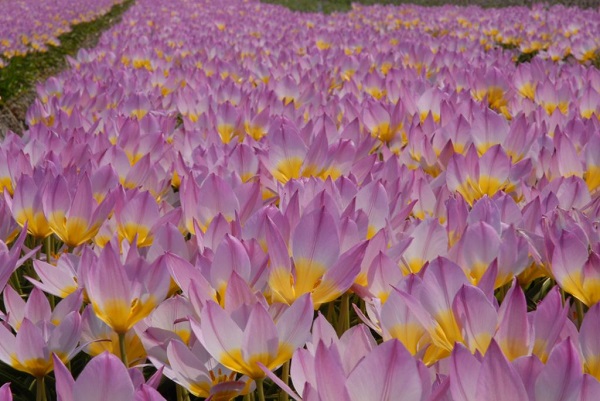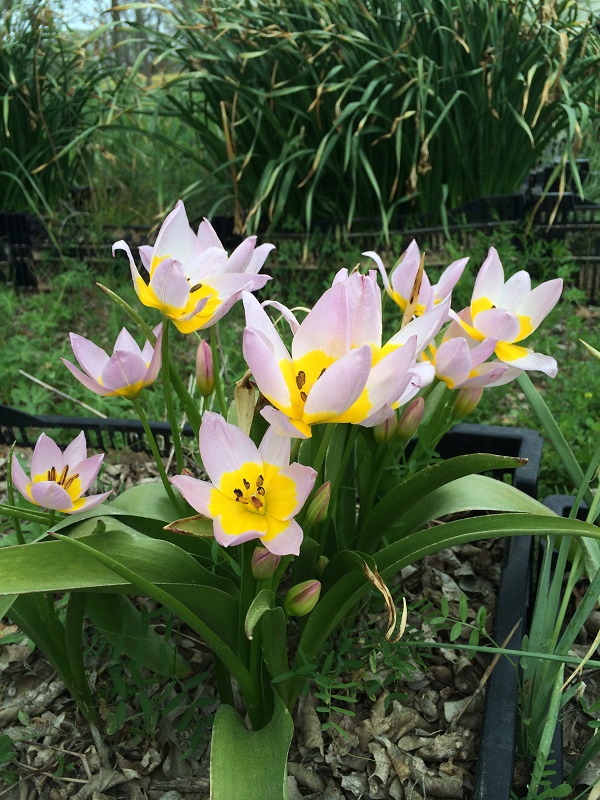

'Lilac Wonder' tulip displays soft lilac/pink petals with a strong yellow base in a combination that will take your breath away. It hasn't been as tough as the other species tulips we have tried. I suggest growing this bulb if you are located in the more northern regions of the South. However, growing them in zone eight on the farm, they continue to come up but not as vigorously as our other species tulips. Although I have my doubts about the 'Lilac Wonder' staying around for the long haul, we have definitely had four years of enjoyment and recommend you share the same experience as us.

If you are going to plant it immediately, the 'Lilac Wonder' tulip does not need to be stored in the fridge. If you are going to wait, then keep the bulbs in the fridge. Tulip blooms bend, move, arc and twist themselves throughout the day in order to orient themselves in the best position to receive light. They reach for it.

Blooms will last well for a couple of weeks, but an unusually hot spring will make the blooms droop. When the tulips are done blooming you may remove the flower stems, but leave the foliage alone to die back on its own. This will allow the bulb to continue to take in nutrients from the sun to last until the next blooming cycle. Once the foliage is completely withered and yellow you can mow right over the top of it.

Care and planting: Plant the tulips in full sun. We often say to plant you tulips "high and dry". That means think about planting in a raised bed that will completely dry out for the summer. Or consider planting them in a crate where the soil can't cling to the roots and the rain water can be absorbed elsewhere. Not only will a crate help protect tulips from rot and help them to perennialize, but critters like voles can't get to them. Don't use "improved" garden soils or place the bulbs in an irrigated area. Plant the bulbs about 3x the height of the bulb deep. You can plant the bulbs as close together as you want to make it look more natural.
For more information on tulips in the South and what you can do to help them survive, please visit our general Tulip information blog post at Bulb Hunter.
'Lilac Wonder' tulip displays soft lilac/pink petals with a strong yellow base in a combination that will take your breath away. It hasn't been as tough as the other species tulips we have tried. I suggest growing this bulb if you are located in the more northern regions of the South. However, growing them in zone eight on the farm, they continue to come up but not as vigorously as our other species tulips. Although I have my doubts about the 'Lilac Wonder' staying around for the long haul, we have definitely had four years of enjoyment and recommend you share the same experience as us.

If you are going to plant it immediately, the 'Lilac Wonder' tulip does not need to be stored in the fridge. If you are going to wait, then keep the bulbs in the fridge. Tulip blooms bend, move, arc and twist themselves throughout the day in order to orient themselves in the best position to receive light. They reach for it.

Blooms will last well for a couple of weeks, but an unusually hot spring will make the blooms droop. When the tulips are done blooming you may remove the flower stems, but leave the foliage alone to die back on its own. This will allow the bulb to continue to take in nutrients from the sun to last until the next blooming cycle. Once the foliage is completely withered and yellow you can mow right over the top of it.

Care and planting: Plant the tulips in full sun. We often say to plant you tulips "high and dry". That means think about planting in a raised bed that will completely dry out for the summer. Or consider planting them in a crate where the soil can't cling to the roots and the rain water can be absorbed elsewhere. Not only will a crate help protect tulips from rot and help them to perennialize, but critters like voles can't get to them. Don't use "improved" garden soils or place the bulbs in an irrigated area. Plant the bulbs about 3x the height of the bulb deep. You can plant the bulbs as close together as you want to make it look more natural.
For more information on tulips in the South and what you can do to help them survive, please visit our general Tulip information blog post at Bulb Hunter.